The residents of Tambor never dreamed they had a secret treasure on their beaches arriving year after year. A group of curious, nature-loving residents wondered if the endangered olive ridley sea turtle still made its way to their bay and decided to go out at night to start watching.
What they discovered astonished them and they realized the turtles faced extreme odds in nature, with an abysmal survival rate. Thus, Tambor Bay Turtles (or TBT) was born. Located on the southern tip of the Nicoya Peninsula, the quiet town of Tambor sits west of Whale Bay (or Bahia Ballena) and is home to hundreds of species of birds, mammals, and now, turtles. Formed in 2015, the intrepid mission of TBT is to protect the remaining sea turtles, as well as to sustain and grow the population naturally.
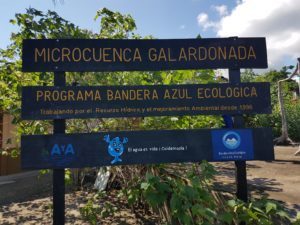
In 2016, they conducted a pilot project to closely study the olive ridley population and observe their behaviour. It was decided that a state-of-the-art hatchery needed to be built to help increase the survival rate of the species, which is being threatened by poaching, harvesting of eggs for human consumption, commercial fishing and coastal development.
Now, the TBT hatchery, which sits on the property of Tambor Tropical resort, boasts an 80% to 90% hatch rate and will be recognized by the Costa Rica Wildlife Foundation as the country’s signature sea turtle project!
TCRN had the chance to interview the TBT Founders – Ron Mills and Juan Carlos Cruz about what inspired them to start this project and the challenges they faced along the way.
Why did you decide to start a turtle hatchery in Tambor? What was your original intent and purpose?
RON: A group of us, including the local businesspeople, were interested in finding out if there were still turtles coming to our beach. We decided to start watching and that’s when we uncovered a treasure we never knew we had! Through our pilot project, we learned they were reproducing at such a slow rate, that if we didn’t intervene to help, they might not make it.
In addition to that, our main objectives were to: promote ecotourism in the region, help fill the hotels and resorts, and also provide an outlet for both expats and locals to spend their time and money working towards something worthwhile. Selfishly, it also gave me something interesting to do in my retirement.
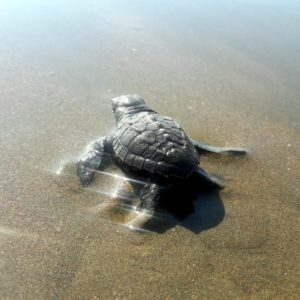
JUAN CARLOS:
Ron Mills (Canadian who resides in Tambor) is an advocate for nature, started with some Los Delfines community members, a group called TANN (Tambor Area Nature Network). The other locals, on the other hand, had been doing our own nature protection and conservation efforts through Tambor Bay Birders, Nicoya Peninsula Birdwatchers and Ecological Blue Flag Certification Program in Tambor. So, when Ron brought up the idea of protecting our sea turtles, it was only natural that we would join forces and make it a reality.
Other goals we had included: contributing to the environmental education of children and adults of our communities and promoting our area as a tourist destination “for the right reasons”, meaning activities that protect nature and promote education.
What unique obstacles or challenges did you encounter along the way while starting up this Turtle program?
RON: It definitely is not for the faint of heart. A project like this can be very time consuming and frustrating at times, especially when dealing with bureaucracy. You have to wait and fight through delays, getting the right permits, etc…However, one exciting thing we are doing this year is to start tagging the turtles we find, to start a database and monitor where they are going.
Another issue we have is attracting the right amount of volunteers. It’s feast or famine, at times. On one shift, we could have 15 volunteers walking the beach and in the next shift, we could have none. The hardest months are right at the beginning of turtle season: July, August and September. By November and December, we normally have a decent group of expats here that can volunteer.
We have an excellent volunteer program and those interested can apply at: https://tamborturtlerescue.org/become-a-volunteer/
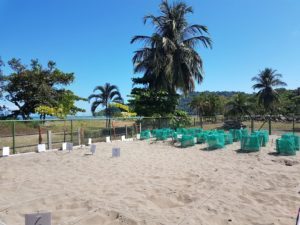
JUAN CARLOS: There are always ups and downs in this kind of project. The biggest challenge was related to a heavy storm we had last year which cost us a few nests. It’s amazing the amount of love that is put by all of us when rescuing the eggs and caring for the baby turtles, so when you lose a few in one single event, this can be heartbreaking. But thanks to that dedication we were still able to close the year with a great survival rate, above 80%.
During 2017 another challenge was the presence of some poachers, but thanks to the work of many of our volunteers and additional environmental education, that problem was significantly reduced.
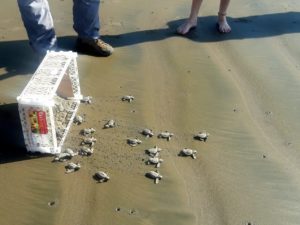
3) What is the biggest lesson you have learned so far in developing this Turtle project?
RON: Patience. Just when you think you have things figured out, you get thrown a curveball. Also, the turtles are very unpredictable and sometimes they are hard to find. You can miss them, because they don’t leave much of a trail.
However, on the positive side, I’ve been pleasantly surprised by how many people are genuinely interested in helping and participating. Once you give somebody a taste of the experience, they become hooked on it and grow to be one of our biggest ambassadors. People come from all walks of life, they don’t necessarily need to have a wildlife or conservation background, but they become enthusiastic supporters of our project. We’re proud to have volunteers from over 20 different countries.
JUAN CARLOS: Education is the key to positively impact the world. It`s never too late to educate or to learn. And that by working together, adding our strengths together and focusing on what bind us, rather than what divides us, we can accomplish anything.
4) What are you most proudest of?
RON: We’ve saved a lot of turtles. And we’ve done this with the help and participation of ordinary people. We’ve done it right and built one of the finest turtle hatcheries in Costa Rica.
It’s something that will endure for decades to come.
It’s also grown to be a community project and we’ve received a groundswell of support, as we continue to gain credibility with the local town. We have our marine biologist, Iratxe Casado, on staff, who is going to local schools and doing presentations with the children. Because of our thoughtful approach, we have created a good buzz that will echo throughout the community.
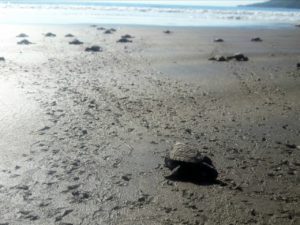
JUAN CARLOS: I’ve always said if we had a top ten of favorite aspects in our life, where things such as family, friends, health would certainly have a predominant place; well, somewhere in there I would have to add being part of a good working team holds a dear place within the top ten.
We live in a wonderful area here; not one day goes by without me appreciating our beautiful Bay. It is in our hands to keep it that way, and in order to accomplish this, the community and especially the youth, have to jump on board to keep it sustainable and long-lasting. We all have our part to play, but it is worth it in the end.

